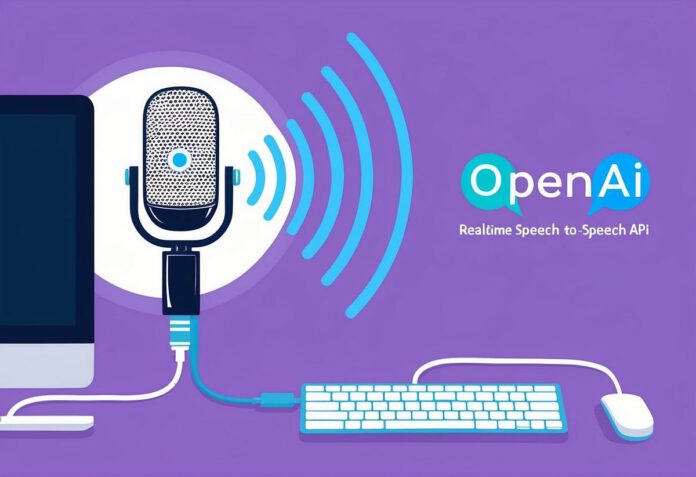
OpenAI’s release of the public beta version of its real-time API for GPT-4o on October 2 marks a significant advancement in voice interaction capabilities.
This development enables the creation of AI applications that facilitate real-time speech-to-speech interactions, bringing AI communication closer to human-like responsiveness.
With an average response time of 320 milliseconds, GPT-4o achieves a level of latency that allows for fluid dialogue, which is a notable improvement over previous iterations. Additionally, its ability to simulate tone and emotion enhances the immersion of interactions, making communication feel more natural.
The introduction of this API signals a promising shift toward practical, real-time dialogue-based AI applications, potentially revolutionizing how developers create AI-driven communication tools.
The involvement of established partners like LiveKit, Twilio, and Agora further underscores the importance of robust real-time communication (RTC) technology in enabling these capabilities.
Agora, known for its work with ClubHouse, along with its Chinese counterpart Sonic Networks, brings valuable experience in the RTC field, which is essential for supporting seamless interactions in this new wave of AI applications.
As RTC technology matures and integrates with multimodal large models, we can expect a proliferation of innovative applications that leverage real-time voice interactions, enhancing user experiences across various platforms and industries. This advancement could lead to more intuitive and engaging AI interfaces, ultimately transforming the landscape of human-computer interaction.
While the technical breakthroughs in end-to-end multimodal models are impressive, the critical role of real-time communication (RTC) technology cannot be overstated. RTC serves as the backbone of effective real-time voice interaction, enabling efficient transmission and processing of speech input.
This begins with the transmission of speech to the server, where the multimodal model processes it. Pre-processing steps, such as noise reduction, gain control, and echo cancellation, are essential for ensuring accurate speech recognition and comprehension by the AI.
The evolution of large models has indeed catalyzed the emergence of end-to-end real-time multimodal models, fundamentally transforming how speech processing occurs in real-time dialogues. The traditional three-step approach, speech recognition, speech-to-text, and text-to-speech, has limitations in responsiveness, making it less suitable for seamless, interactive communication.
The advancement of big model capabilities allows these models to directly handle speech, significantly improving responsiveness and reducing latency in conversational AI systems.
As the technical challenges surrounding speech processing are addressed, key players in the AI landscape are quickly adapting to leverage these innovations. For instance, Character AI’s new voice feature generated immense interest, attracting over 20 million calls from 3 million users shortly after launch.
This indicates a strong market demand for interactive voice capabilities. Similarly, Microsoft is poised to introduce a real-time voice interface that will enable dynamic user interactions, showcasing how established tech companies are racing to integrate real-time voice features into their platforms.
In China, Zhipu AI’s launch of a C-suite-oriented video calling feature exemplifies the growing trend of incorporating voice and video interactions into applications, enhancing user experiences by mimicking real-life conversations.
This functionality supports various everyday scenarios, including learning assistance and object recognition, highlighting the practical benefits of integrating multimodal capabilities.
iFLYTEK’s multi-modal visual interaction technology and hyper-realistic virtual human interaction represent another significant advancement, enhancing interaction by focusing on response speed, emotional perception, voice expressiveness, and persona play.
The advancement from RTC (Real-Time Communications) to RTE (Real-Time Engagement) signifies a notable shift in interactive technology, particularly for multimodal AI models. The process of real-time voice interaction involves essential steps: pre-processing speech data to enhance audio quality, recognizing and understanding speech, generating responses through AI models, and synthesizing speech to transmit back to users.
Utilizing RTC technology has proven to significantly reduce response latency, improving traditional AI voice dialogue from 4-5 seconds to 1-2 seconds, and with end-to-end processing, to just a few hundred milliseconds.
This reduction enhances interaction speed and contributes to a more intelligent and realistic dialogue experience. However, real-world challenges persist, especially when users aren’t connected to stable networks, which can affect the performance of voice interactions.
Despite these hurdles, the evolution to RTE emphasizes the importance of situational context in real-time interactions. As RTC transitions into an infrastructure-level capability, the emergence of RTE represents a new focus on enhancing user experience through shared spaces and time, marking a significant leap forward in the potential of AI-driven communication technologies.
The upcoming RTE Conference promises to be a significant event, featuring prominent figures and innovative discussions on the intersection of AI and real-time interaction. Key players like Zhipu AI and MiniMax, both with substantial experience in their respective domains, will share insights on RTE technology development.
Esteemed AI scientist Jia Yangqing, known for his work in AI infrastructure, will offer his perspectives on the future trends of RTE and AI. The event will include seven industry sub-forums covering diverse topics such as AI+IoT, education, and digital transformation, with over 50 industry leaders providing insights and case studies.
In addition to industry applications, the conference will feature five technical sessions led by over 30 experts focusing on various aspects of AI technology, including audio, video, RTC integration, and cloud architecture. A special workshop will also allow developers to engage hands-on with open-source frameworks, fostering innovation in AI real-time interaction.
Reflecting on the conference’s history, the RTE Conference has evolved alongside advancements in technology, becoming a vital platform for discussing the role of real-time interactive technology in everyday life. This year marks its 10th anniversary, coinciding with the emergence of a new wave of innovation driven by AI and real-time interaction.
Attendees can expect to explore groundbreaking ideas and applications at the forefront of this transformative change, making the RTE Conference a must-attend event for anyone interested in the future of real-time interaction technologies.
Source: aibase, medium



